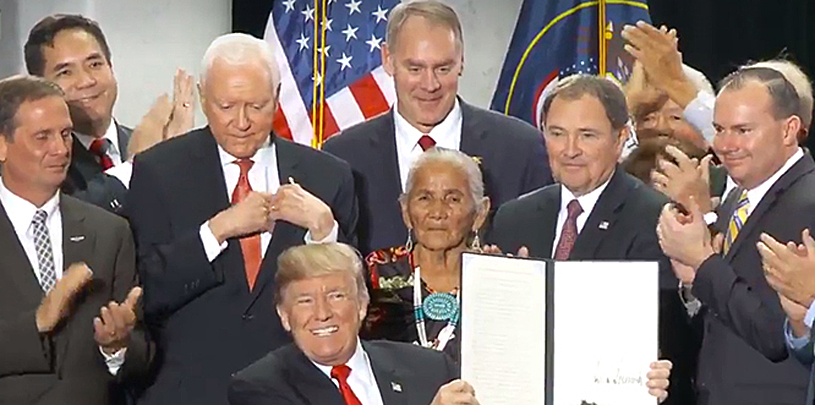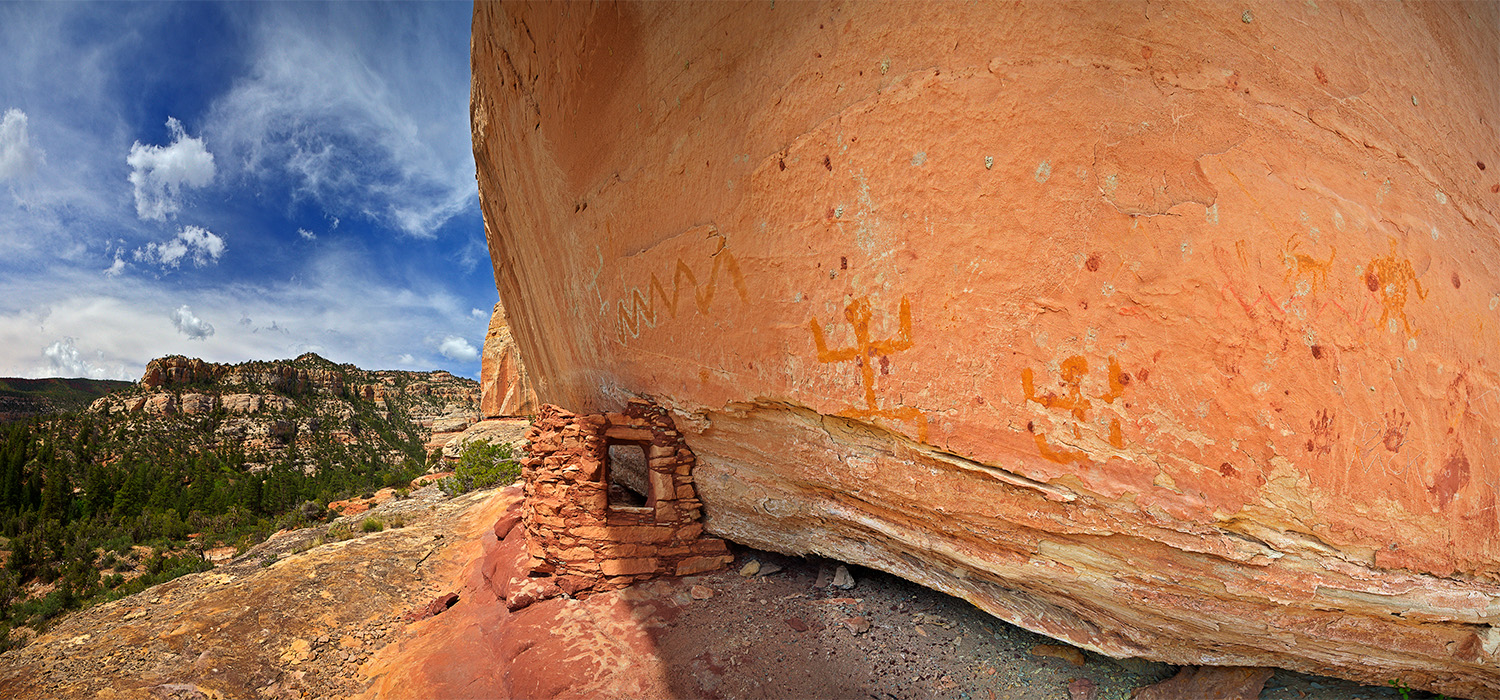
 by Tim Peterson, Utah Wildlands Director
by Tim Peterson, Utah Wildlands Director
On December 4, 2017, President Trump slashed Bears Ears and Grand Staircase-Escalante national monuments, removing national monument protections from over 2 million acres of public lands. In doing so, he used authority he does not have under the Antiquities Act of 1906, which allows presidents to create national monuments, but not to eliminate or reduce them.
Trump’s new monument proclamations strip protections from cultural and historic sites, fossils, and stunning geologic features — all “objects of historic and scientific interest” as defined by the Antiquities Act. President Theodore Roosevelt signed the act in 1906 in response to the rampant looting and destruction of Native American archaeological and cultural sites. Since 1906, all but three presidents have used it to protect lands and objects for future generations. Last Monday, Trump broke with that 111-year tradition, instead using the act to unprotect, among other things, sinuous slot canyons, cliff dwellings, and one of the oldest rock art panels in Utah.
Let’s examine a few of the claims President Trump and Interior Secretary Ryan Zinke have made about the monument decisions and sort the facts from the “alternative facts.”
“…past administrations have severely abused the purpose, spirit, and intent of a century-old law known as the Antiquities Act. This law requires that only the smallest necessary area be set aside for special protection as national monuments. Unfortunately, previous administrations have ignored the standard and used the law to lock up hundreds of millions of acres of land and water under strict government control.”
-President Donald Trump
The truth is national monuments designated under the Antiquities Act do not “lock up” public land; they protect irreplaceable archaeological resources and other lands and objects of interest to scientists. National monuments are open to public use and visitation, but closed to new mining and fossil fuel development that may impair the objects monuments protect.
The original decisions to designate Bears Ears and Grand Staircase-Escalante national monuments were based on careful and extensive research and well-documented “objects of historic and scientific interest.” While monuments greater than a million acres like Bears Ears and Grand Staircase may seem large, this is the smallest area compatible with proper care and management of the objects the monuments sought to protect, including, in the case of Bears Ears, the road systems, dwellings, granaries, and burial grounds of ancient civilizations whose descendants continue to pray, hunt, and gather medicinal and ceremonial plants at Bears Ears today. The issue of size was settled by the Supreme Court in 1920, when it ruled that large monument designations are well within a president’s discretion and the scope of the Antiquities Act. The court affirmed President Theodore Roosevelt’s 800,000-acre Grand Canyon designation. Courts also affirmed the 1.8 million acre Grand Staircase Escalante National Monument designation in 2004.
“Here, and in other affected states, we have seen harmful and unnecessary restrictions on hunting, ranching, and responsible economic development…We have seen how this tragic federal overreach prevents many Native Americans from having their rightful voice over the sacred land where they practice their most important ancestral and religious traditions.”
-President Donald Trump
The truth is no lands were closed and no access was blocked by the Bears Ears and Grand Staircase national monument designations. Motorized recreation, hunting, fishing, camping, grazing, and firewood and herb collection are still allowed in national monuments. Permitted livestock grazing has actually increased in parts of Grand Staircase.
The 2016 monument proclamation for Bears Ears specifically protected traditional access for Native Americans, created a five-tribe commission to help determine how to manage the land, and, for the first time ever, honored Native American traditional knowledge as a resource to be protected. In fact, an inter-tribal coalition petitioned for a Bears Ears National Monument in the first place, as a way of protecting their cultural heritage against rampant looting and desecration, making it the first truly Native American monument. President Trump’s remarks and decision insult the Native American people who have visited and called Bears Ears home since time immemorial and worked for years to see it protected as a national monument.
“President Trump and his Administration are being open and transparent in the review of monuments.”
-The White House
“The people of Utah overwhelmingly voiced to us that public land should be protected not for the special interests, but for the citizens of our great country who use them, and this is what President Trump is doing today.”
-Secretary of the Interior Ryan Zinke
Unlike the public hearing held by former Interior Secretary Sally Jewell prior to the Bears Ears National Monument designation, Secretary Zinke’s national monument review was largely a behind-closed-doors process. Secretary Zinke and President Trump ignored the 88% of self-identified Utahns who asked them to keep national monuments intact. Secretary Zinke’s meeting with the five Native American tribes that proposed Bears Ears National Monument lasted only one hour, not "just under two hours" as the Department of the Interior’s press release indicates. During Secretary Zinke’s remaining four days in Utah, he only met with Native American individuals opposed to a monument, not elected tribal leaders. He ignored the statements and support of the National Congress of American Indians, the Utah Tribal Leaders Association, and over 30 Native American tribes.
The Trump administration did not meaningfully consult with any of the sovereign tribes with ties to Bears Ears, did not seek counsel on the boundary decisions, and President Trump neglected to call any tribal leaders to announce his decision, though he did personally contact Utah congressmen. Native American tribes are not “special interest” groups. They are sovereign governments with a unique political relationship that was disrespected by this review and decision. The only special interest groups that stand to benefit from this decision are Utah politicians and mining and oil and gas interests. The areas cut from the monuments are reopened to oil and gas leasing and mining after 60 days.
“Our precious national treasures must be protected. And they, from now on, will be protected.”
-President Donald Trump
This is perhaps the biggest whopper of them all. President Trump did not protect precious national treasures. He actually removed protections from over 2 million acres that contain some of the most spectacular and unique cultural and natural resources in the United States. Alternative facts, indeed — this is the real “fake news.”
Beyond just words, President Trump’s unpopular, unjust, and, we believe, unlawful, actions have done real harm. They represent the most sweeping attack on protected public lands in American history. We know you care about our national monuments too.
Please help us restore protections for our national treasures by contributing to our defense of Bears Ears and Grand Staircase-Escalante national monuments. We’re counting on your support to right this wrong.

Cultural landscapes are full of stories, artifacts, and resources to appreciate. Here's how ›
Utah voters strongly support national monuments in general, and Bears Ears and Grand Staircase-Escalante in particular, a new poll shows.
Read MoreA small victory in the legal case challenging Daneros uranium mine, near Bears Ears National Monument.
Read MoreBears Ears petroglyph panels and cultural sites protected by new proposed management plan.
Read More